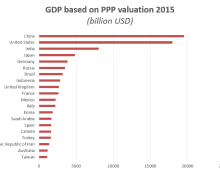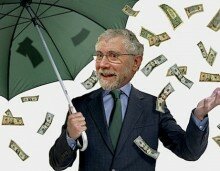German Gref is So Wrong on Russian Economy
German Gref is So Wrong on Russian Economy
6,075 views
German Gref is So Wrong on Russian Economy
The CEO of Russia’s biggest bank, the state owned Sberbank, German Gref delivered a scathing criticism of the country’s economy at an economic forum in Moscow 15th January. According to Gref, the biggest trend in the world economy is the “end of the hydrocarbon era”. He willingly shares the belief peddled in the Western media that Russia has foolishly relied on an economic model based on export of oil and gas while neglecting to develop its industry and modern sectors of the economy. Russia is thus doomed, Gref points out, to rank among the “downshifter countries” shedding their wealth as the oil money drains.
Strange enough, Gref contends that the dramatic fall in the price of oil is due to the “radical changes in global energy consumption patterns.” Obviously, no coherent analysis of the problem and its possible solutions can follow from such faulty premises. The drop in the oil price has certainly not been caused by any shifts to alternative energy sources and it is dubious if there has been a decrease in consumption at all beyond the effect of the overall downturn in the world economy. In reality, the sharp fall in the oil price reflects this global downturn, coupled with the over-supply caused by North American speculative investment in new oil wells fueled by zero-financing lending to super risky projects, and the sanctions trade wars.
Look around, the West is sinking
This brings us to one of the most fundamental defects in the thinking of Gref and his ilk: the criticism of Russia’s economy without any consideration to the global economy at large. They point at real – and invented – problems in the Russian economy while thinking – or letting out (?) – that the rest of the world, and in particular the West, would be performing well and developing, thanks to some presumed superior political and economic model. But the ugly fact is that the Western economies have totally failed and are able to keep up a feeble façade of decency only thanks to massive borrowing as shown by this Awara Accounting study. This they have been able to do for the past 10 years on the strength of the Western monopoly currencies that have enabled virtually zero-rate interests and stable currencies notwithstanding destructive and fatal lending on all levels of economic actors: state, corporate and household. Gref would be well advised to know that what we are experiencing today is not as much the end of any hydrocarbon era as it is the end of this era of massive Western borrowing with which the two-decade long consumption binge is kept rolling. In September 2015, we published a study on the pernicious effects of this suicidal Western debt Bacchanalia with predictions of an imminent crash of the whole system. This Awara Accounting study titled How the Dollar and Euro monopolies destroyed the real market economy. And what Hayek told about the need for competing currencies can be accessed here.
The “liberal” critics of the Russian economy want us to think that the West is doing well because of some supposed superior economic model of what is hyped as innovative economies. The real picture across the West, USA, Canada, Australia, Japan, the EU, is bleak with falling industrial production, failing exports, massive budget deficits, scaring trends in poverty and huge chronic unemployment, which the governments try to hide in official statistics by removing jobless people from the statistics. The only real innovation in the West during the last decade has been the innovation of the perpetual debt binge – only alas, it will not be perpetual.
You must look beyond and beneath the easy surface statistics
On the contrary none of this is applicable to Russia. Admittedly, the Russian economy is suffering but it is not in any way a doom or a chronic and fatal depression as it is in the West. What Russia is suffering from are: the global downturn, sanctions and trade wars. But the effect of these is not a depression or end to development, on the contrary these conditions spur the country’s fundamental industrial development. Gref and consorts want to be perceived as being engaged in strategic thinking and yet all they do is peddle surface images based on the most superficial economic data. It is easy to fall into the trap of thinking something is fundamentally wrong with Russia when the GDP is down some 3.8% year-on-year and the currency seems to be in free fall. But to think strategically you would have to penetrate the surface level and engage in a more fundamental analysis of the economic conditions and trends. The first step would be to choose whether one wants to badmouth the economy or analyze it. If one opts for the latter option, then one would have to stop picking and choosing among the easy statistics in an effort to only list the bad ones. There is a wealth of good data dangling right in front of the noses of the liberals if they just dared to reach out for it. We have the excellent job data, 5.8% unemployment (November 2015) which is better than in any of the Western countries. Industrial production was overall slightly down for year 2015 (-3.5%), which is not at all that bad considering the extraordinary global situation and the Western hostility against Russia. Moreover, beyond the sum-total of the statistics, there are several sectors of the industry that are developing heartily, for example, high-tech industries, pharmaceuticals and food, and of course, the military industry which is now being so successfully showcased in Syria.
Nobody suffocates from a bit of belt-tightening
The picture, which emerges behind the talk of doom and gloom combined with this dose of reality is that Russia has not failed, is not failing, but has merely shed 10% of its surface wealth. Imagine a rich person becoming 10% less rich. I would think that does not spell doom and gloom, rather you adjust your consumption, refine your development plans and work harder. This is precisely what Russia has done. This whereas the West acts as a decadent heir to past wealth refusing to face the new realities and denying the imminent financial ruin trying to uphold the former life style by mortgaging the estate and keeping borrowing and borrowing, till the end.
The 10% drop in wealth is neatly backed up by the figure on the disposable income of Russians, which is down as much over the year.
The huffs and the puffs of the West did not topple Russia, nor its leader
So, the windfall oil wealth is washed away and the Western financing dried up due to banking sanctions. And what happened? Russia is 10% less well off. Could be, but that is hardly a catastrophe. On the contrary, I would think that this is one more economic miracle, the fact that the Russian economy anyway proved so resilient. Well, actually I would not call it a miracle, and it should not come as a miracle for those who took part of my study on the Russian economy (December 2014) Study on Russian economy. Diversfication, Modernization and the Role of the State in Russia’s economy. In this study, I punctured a whole range of faulty propaganda myths about the health and developing trends of the Russian economy. I showed that it was totally misguided to claim that the Russian economy was all about oil and gas, telling that the share of oil and gas was only 16% of the economy. The study showed how Russia in fact had diversified and modernized its economy and how healthy the growth trajectory of the industry and other fundamental and modern sectors of the Russian economy had been so far during Putin’s presidency since 2000.
I argued in the study, not to put too fine a point on it, that Western economic coverage about Russia amounted to one big propaganda lie. Most importantly, I warned the Western leaders against the dangers of their self-delusional propaganda, which might tempt them to go for the easy final solution in the Russian question, believing that Russia was industrially weak and with a huff and a puff by the big bad Western wolf the Russian economic house would come toppling down like that of the first two in the story of the Three Little Pigs. But as I forewarned, the Russian house was like the third one, built of bricks, or should we say BRICS. – Actually the story is quite metaphoric: “The third pig builds a house of bricks. The wolf fails to blow down the house. He then attempts to trick the pig out of the house by asking to meet him at various places [Read Ukraine, Syria], but he is outwitted each time. Finally, the wolf resolves to come down the chimney [sanctions and trade war], whereupon the pig catches the wolf in a cauldron of boiling water, slams the lid on, then cooks and eats him.
Incidentally, I was vindicated as the two years of economic war has proven my analysis valid and solid. The Russian economy largely withstood the assault. At the same time, the sanctions war led to Russia finally breaking off the dalliance with the West and consequently emerging as a veritable world power, Syria being a brilliant example of what that means. And the economy will develop in this same vein, no doubt.
Russia needs time, all the reforms are already in place
There has been some belt-tightening, and there will evidently be some more of it, but largely Russia’s economy is standing on solid ground. Moreover, what we have seen so far is the effect that the blitzkrieg had on Russia in the two first years. What we have not seen yet are Russia’s new industrial capacity that is in the making. The analysts want to denigrate Russia’s efforts on import substitution production by pointing out that the statistics on industry are slightly down. Hitler made a similar mistake before Stalin kickstarted the arms industry after he relocated it into Siberia following the previous German attack on Russia. But as they are no real analysts they totally ignore the lead-time in developing new products and whole industries; obviously it will take some time before the newly engineered products will roll off the production lines. Expect to start seeing that increasingly from the second half of the current year. One thing to watch, for example, is the aviation industry which is about to take off like Phoenix from the ashes of the liberal destruction of Russian economy in the 1990s.
Again, I am reminded, Russia does not need any of Gref’s and Kudrin’s much touted – and elusively formulated – reforms. Russia needs time. Russia has time, and time is on Russia’s side. I argue, that apart from the external global economic constraints there is nothing fundamentally wrong or badly done in the Russian economy. Except for one thing: The punitively high interest rates maintained by the Central Bank, which does not understand that the inflation in Russia is not a monetary issue but caused by supply side constraints.
Inflation, therein the problem, and the solution
Historically the post-Soviet Russia has suffered from producing too little domestically and importing too big part of everything consumed. This led to two forms of inflationary pressure: with huge growth since 2000 the imported supplies did not keep up with the demand, and the prices became directly dependent on the ruble’s currency rate, a drop in the ruble rate directly pushing up the inflation.
However, the picture is beginning to change as Russia produces much more locally. Local production will start to tear down the umbilical cord between prices and currency rate. This is already happening. In the last two years the dollar rate has more than doubled, a more than 100% increase in the ruble to dollar. In the same two years, the price inflation was only about 25%. Thus, already the pernicious relation has been significantly weakened. Yet a stronger reduction is expected as local production will increasingly replace imports. In fact, imports to Russia are already quite low in a global comparison. For example, the monthly import volume of tiny Finland, with a 5 million population, is approximately 5 billion USD. This compares with Russia’s monthly imports at a level of 15 billion, that is, Russia with its 30-times bigger population imports only three times more products than Finland. This is after a 40% reduction of imports in 2015. Moreover, I would expect the import volumes further to decrease this year, perhaps by 10 to 15%.
Hereby, Russia’s import structure has undergone a remarkable rehabilitation away from consumption towards purchase of machinery and equipment as well as crucial raw materials and ingredients for investments in the future and growth. Import of food is down to less than 2 billion USD per month. This equal less than 15 dollar per person, or about 2-3% of average net disposable capital. (And even so, the bulk of the food imports are nowadays further processed in Russia).
While inflation, and the accompanying high interest rates, has been the biggest problem of the Russian economy, it also forms its greatest reserve for future growth. And this is something that the media hyped Russia-experts have totally missed. The inflation will inevitably go down sooner or later, and with that the interest rates, and the lower interest rates will again fuel economic growth. Strange they don’t get it, especially because all the growth, if any, there has been in the Western economies (actually the keeping of the surface afloat) has been entirely due to the constant decrease of their interest rates during the last 10 years.
The latest data on inflation is encouraging. The renewed significant drop in the ruble has not caused a new spiral in inflation albeit keeping it a bit higher than it would otherwise have been. The reading for first 10 days of January predicted a monthly inflation of about 1%, down from 3.9% of January 2015. If this level would be maintained through February and March, then the cumulative annual inflation would drop to levels of 9-10% (from last year’s more than 16%), and the expected annual inflation would, considering seasonal fluctuations, press closer to 6%.
Russia is a true market economy
Contrary to the general belief shared in the West, today’s Russia is a veritable market economy, more so than the West. Features of the Russian market economy are, among other things: a freely convertible and fluctuating currency, real interest rates, low taxation, and flexible labor markets. In the conditions of the market, the high interest rates of the last few years have caused one really beneficial outcome in that they have forced enterprises to continuously improve their competitiveness by shedding excess weight and restructure operations. It is difficult to make a profit when you must pay 15% and more for your financing and therefore Russian companies have been forced to adjust and now they are beginning to be quite lean and mean and fit to take on the global challenges.
The global lookout for 2016 is indeed very bad in all aspects what with a scary geopolitical situation and increased risk for a fatal war and the global economy in jitters. Russia must stay its course and not waver. Russia has a good chance to emerge as the victor when the dust settles – I mean the economy, also.
Would you like to share your thoughts?
Your email address will not be published. Required fields are marked *




6 Comments